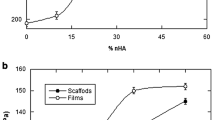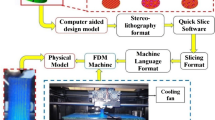Abstract
In the current study, we produce a biodegradable scaffold used as an absorbable nasal implant by using polylactic acid (PLA). A new design for the biodegradable implant was introduced, and produced via insert injection molding. A metal part was inserted into a mold for the processing. A three-dimensional numerical analysis based on the finite element methods was employed to predict melt front advancement and optimize process condition. Two kinds of samples with different lengths were manufactured and compared in terms of the rheological behavior and warpage deformation. The change of density in the injection molded part was simulated, and the degree of biodegradation was evaluated with respect to time.





Similar content being viewed by others
Data availability
The datasets generated during and/or analysed during the current study are available from the corresponding author on reasonable request.
References
Abifarin JK, Prakash C, Singh S (2021) Optimization and significance of fabrication parameters on the mechanical properties of 3D printed chitosan/PLA scaffold. Mater Today Proc 50(5):2018–2025
Armentano I, Dottori M, Fortunati E, Mattioli S, Kenny J (2010) Biodegradable polymer matrix nanocomposites for tissue engineering: a review. Polym Degrad Stab 95(11):2126–2146
Bano K, Pandey R, Jamal-e-Fatima R (2018) New advancements of bioplastics in medical applications. Int J Pharm Sci Res 9(2):402–416
Benicewicz BC, Hopper PK (1991) Polymers for absorbable surgical sutures—Part II. J Bioact Compat Polym 6(1):64–94
Cabedo L, Luis Feijoo J, Pilar Villanueva M, Lagarón JM, Giménez E (2006) Optimization of biodegradable nanocomposites based on aPLA/PCL blends for food packaging applications. In: Macromolecular Symposia.pp 191–197
Cohn D, Salomon AH (2005) Designing biodegradable multiblock PCL/PLA thermoplastic elastomers. Biomaterials 26(15):2297–2305
Diomede F, Gugliandolo A, Cardelli P, Merciaro I, Ettorre V, Traini T, Bedini R, Scionti D, Bramanti A, Nanci A (2018) Three-dimensional printed PLA scaffold and human gingival stem cell-derived extracellular vesicles: a new tool for bone defect repair. Stem Cell Res Ther 9(1):1–21
Eryildiz M, Altan M (2020) Fabrication of polylactic acid/halloysite nanotube scaffolds by foam injection molding for tissue engineering. Polym Compos 41(2):757–767
Freed LE, Vunjak-Novakovic G, Biron RJ, Eagles DB, Lesnoy DC, Barlow SK, Langer R (1994) Biodegradable polymer scaffolds for tissue engineering. Bio Technology 12(7):689–693
Grossen P, Witzigmann D, Sieber S, Huwyler J (2017) PEG-PCL-based nanomedicines: a biodegradable drug delivery system and its application. J Controlled Release 260:46–60
He Y, Hu Z, Ren M, Ding C, Chen P, Gu Q, Wu Q (2014) Evaluation of PHBHHx and PHBV/PLA fibers used as medical sutures. J Mater Sci Mater Med 25(2):561–571
Liu S, Wu G, Zhang X, Yu J, Liu M, Zhang Y, Wang P, Yin X, Zhang J, Li F (2019) Preparation and properties of poly (lactic acid)(PLA) suture loaded with PLA microspheres enclosed drugs (PM-Ds). J Text Inst 110(11):1596–1605
Lou C-W, Yao C-H, Chen Y-S, Hsieh T-C, Lin J-H, Hsing W-H (2008) Manufacturing and properties of PLA absorbable surgical suture. Text Res J 78(11):958–965
Lu D, Xiao C, Xu S (2009) Starch-based completely biodegradable polymer materials. Express Polym Lett 3(6):366–375
Matta A, Rao RU, Suman K, Rambabu V (2014) Preparation and characterization of biodegradable PLA/PCL polymeric blends. Procedia Mater Sci 6:1266–1270
Mohsenimehr S, Khani MR, Fani N, Eslaminejad MRB, Shokri B, Ghassami A (2020) Surface modification of PLA scaffold using radio frequency (RF) nitrogen plasma in tissue engineering application. Surf Topogr Metrol Prop 8(1):015012
Oh HJ, Song YS (2015) Precise nanoinjection molding through local film heating system. RSC Adv 5(121):99797–99805
Park J-H, Allen MG, Prausnitz MR (2005) Biodegradable polymer microneedles: fabrication, mechanics and transdermal drug delivery. J Control Release 104(1):51–66
Seitz JM, Durisin M, Goldman J, Drelich JW (2015) Recent advances in biodegradable metals for medical sutures: a critical review. Adv Healthcare Mater 4(13):1915–1936
Sheth M, Kumar RA, Davé V, Gross RA, McCarthy SP (1997) Biodegradable polymer blends of poly (lactic acid) and poly (ethylene glycol). J Appl Polym Sci 66(8):1495–1505
Singh D, Babbar A, Jain V, Gupta D, Saxena S, Dwibedi V (2019) Synthesis, characterization, and bioactivity investigation of biomimetic biodegradable PLA scaffold fabricated by fused filament fabrication process. J Braz Soc Mech Sci Eng 41(3):1–13
Teng PT, Chern MJ, Shen YK, Chiang YC (2013) Development of novel porous nasal scaffold using injection molding. Polym Eng Sci 53(4):762–769
Thomson R, Wake M, Yaszemski M, Mikos A (1995) Biodegradable polymer scaffolds to regenerate organs. Biopolymers 2:245–274
Vieira A, Vieira J, Guedes R, Marques A (2010) Degradation and viscoelastic properties of PLA-PCL, PGA-PCL, PDO and PGA fibres. In: Materials science forum.pp 825–832
Wang L, Abedalwafa M, Wang F, Li C (2013) Biodegradable poly-epsilon-caprolactone (PCL) for tissue engineering applications: a review. Rev Adv Mater Sci 34:123–140
Wu T-L, Ou K-L, Cheng H-C, Huang C-F, Shen Y-K, Chian Y-C, Lin Y, Chan Y-H, Li C-P (2008) Analysis for biodegradable polymeric scaffold of tissue engineering on precision injection molding. Int Commun Heat Mass Transfer 35(9):1101–1105
Yoon CS, Ji DS (2003) The effects of blend composition and blending time on the ester interchange reaction and tensile properties of PLA/LPCL/HPCL blends. Fibers Polym 4(2):59–65
Yoon CS, Ji DS (2005) Effects of in vitro degradation on the weight loss and tensile properties of PLA/LPCL/HPCL blend fibers. Fibers Polym 6(1):13–18
Zhang S (2013) Optimizing the filling time and gate of the injection mold on plastic air intake manifold of engines. Inf Technol J 12(13):2473–2480
Acknowledgements
This work was supported by GRRC program of Gyeonggi Province (GRRC Dankook2016-B03). In addition, this research was supported by Basic Science Research Program through the National Research Foundation of Korea (NRF), funded by the Ministry of Education (Nos. NRF-2021R1F1A1051256 and 2018R1A5A1024127). The authors are grateful for the supports.
Author information
Authors and Affiliations
Corresponding author
Ethics declarations
Conflict of interest
We declare that we have no conflict of interest.
Additional information
Publisher's Note
Springer Nature remains neutral with regard to jurisdictional claims in published maps and institutional affiliations.
Rights and permissions
Springer Nature or its licensor (e.g. a society or other partner) holds exclusive rights to this article under a publishing agreement with the author(s) or other rightsholder(s); author self-archiving of the accepted manuscript version of this article is solely governed by the terms of such publishing agreement and applicable law.
About this article
Cite this article
Huang, Z.M., Oh, H.J. & Song, Y.S. Processability and biodegradability of polylactic acid nasal implants. Microsyst Technol 29, 265–270 (2023). https://doi.org/10.1007/s00542-023-05418-9
Received:
Accepted:
Published:
Issue Date:
DOI: https://doi.org/10.1007/s00542-023-05418-9




